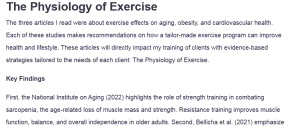The Physiology of Exercise
The three articles I read were about exercise effects on aging, obesity, and cardiovascular health. Each of these studies makes recommendations on how a tailor-made exercise program can improve health and lifestyle. These articles will directly impact my training of clients with evidence-based strategies tailored to the needs of each client: The Physiology of Exercise.
Key Findings
First, the National Institute on Aging (2022) highlights the role of strength training in combating sarcopenia, the age-related loss of muscle mass and strength. Resistance training improves muscle function, balance, and overall independence in older adults. Second, Bellicha et al. (2021) emphasize the effectiveness of combining aerobic and resistance training for managing obesity.
Their review of 149 studies demonstrates how exercise promotes fat loss while preserving lean muscle mass and improving mental well-being. Lastly, Ghodeshwar et al. (2023) examine the impact of lifestyle modifications, including exercise, on cardiovascular health. Regular moderate-intensity exercise is shown to improve blood pressure, cholesterol profiles, and vascular function, reducing the risk of cardiovascular disease.
Application to Practice
These findings will allow me to develop safe, evidence-based programs tailored to the needs and goals of clients. Progressive strength training in older clients will aid these clients in maintaining muscle mass and enhance the performance of everyday activities. Aerobic and resistance exercises combined for clients with obesity will address physical and psychological problems and foster weight management that is more manageable to maintain.
The most significant benefit for individuals with the risk of cardiovascular disease will be the improvement in heart health with minimized risks, hence safe progress toward fitness goals. These studies also impress on the holistic effects of exercise, including in improving the quality of life, mental health, and observance of long-term health goals.
Conclusion
With these insights integrated into the course concepts of homeostasis and biological control systems, I shall now be able to formulate appropriate and individual exercise prescriptions. The strategies will help clients not only in achieving their goals of fitness but also in promoting long-term health and wellness. By so doing, I will be poised to serve all client populations by combining research-based knowledge with practical application.
References
Bellicha, A., Baak, M. A., Battista, F., Beaulieu, K., Blundell, J. E., Busetto, L., Carraça, E. V., Dicker, D., Encantado, J., Ermolao, A., Farpour‐Lambert, N., Pramono, A., Woodward, E., & Oppert, J. (2021). Effect of exercise training on weight loss, body composition changes, and weight maintenance in adults with overweight or obesity: An overview of 12 systematic reviews and 149 studies. Obesity Reviews, 22(S4). https://doi.org/10.1111/obr.13256
Ghodeshwar, G. K., Dube, A., & Khobragade, D. (2023). Impact of lifestyle modifications on cardiovascular health: A narrative review. Cureus, 15(7). https://doi.org/10.7759/cureus.42616
National Institute on Aging. (2022, June 30). How can strength training build healthier bodies as we age? National Institute on Aging. https://www.nia.nih.gov/news/how-can-strength-training-build-healthier-bodies-we-age
ORDER A PLAGIARISM-FREE PAPER HERE
We’ll write everything from scratch
Question
Assignment Content
This week’s assignment:
For this assignment, research one topic in exercise physiology and write a response to what you find.
Do not use a search engine such as Google.
Go to PubMed and click PubMed Quick Start Guide to get an overview of the site. Type the phrase into the search box and click Search. Examples include “aging and exercise,” or “multiple sclerosis.” Select three articles that may interest you and email them to yourself using the Send To pull-down menu.
Once you have browsed the articles, write a statement of at least 300 words on how the information in these articles will help your work with clients. A good place to focus in each article are the “abstract,” “introduction,” “findings,” and “discussion” or “conclusion” sections.
The website is located at www.ncbi.nlm.nih.gov/pubmedLinks to an external site.. You may use information from the course text as well as the research articles to formulate your answer.
You will be graded on your ability to critically apply what you find in the research with your answer.

The Physiology of Exercise
01 Readings:
In addition to the lectures, it is very important that you also read along in your book, Exercise Physiology: Theory and Application to Fitness and Performance, in order to fully understand each lesson’s content. Though the lecture is quite comprehensive, your textbook includes additional illustrations, vocabulary and supplementary materials that help enhance each week’s material.
This week, please read the following:
- Powers, S. (2023). Exercise Physiology: Theory and Application to Fitness and Performance (12th ed.). McGraw-Hill Higher Education (US). https://online.vitalsource.com/books/9781266201882
-
- Introduction
- Chapter 1
- Chapter 2
-
- 01 Weblinks
- Introduction to Exercise Physiology, Common Measurements, and the Internal Environment
- Below are links to resources that will complement the material covered this week.
- Healthy Children – a site dedicated to health and fitness for children, created by the American Academy of Pediatrics. Material includes fitness and exercise resources for toddlers, preschoolers, grade schoolers, and teenagers.
-
- https://www.healthychildren.org/English/ages-stages/teen/fitness/Pages/default.aspx Links to an external site.
-
- Harvard Medical School Harvard Health Publishing- articles written by Harvard University doctors, faculty, and staff about exercise and fitness for all ages. Site includes an e-learning course and downloadable report on healthy living.
- https://www.health.harvard.edu/topics/exercise-and-fitness Links to an external site.
- Cell Signaling – Khan Academy video examining the basic principles of how cells communicate with one another through signaling.
- “Overview of Cell Signaling”
- Medical News Today – Research-based article highlighting the link between exercise and appetite.
- “How exercise tells the brain to curb appetite”
- https://www.medicalnewstoday.com/articles/321660.phpLinks to an external site.
- “How exercise tells the brain to curb appetite”
- Healthy Children – a site dedicated to health and fitness for children, created by the American Academy of Pediatrics. Material includes fitness and exercise resources for toddlers, preschoolers, grade schoolers, and teenagers.

